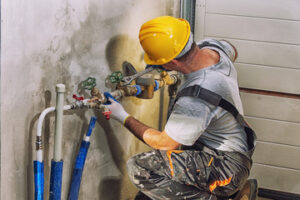Plumbing is an area of engineering that uses pipes, valves, plumbing fixtures, tanks, and other apparatuses to convey fluids. These systems are used in a wide variety of applications, including the home. Whether you’re renovating an existing home or installing a new one, you’ll want to be familiar with the different types of plumbing systems and the codes that must be followed during installation.

The plumbing system of your house includes sinks, toilets, and drains. Having basic knowledge about these systems will help you avoid a lot of trouble, including gurgling faucets, clogged drains, and leaky pipes. Plumbing basics also include how to replace a water heater and use a garbage disposal. It is vital to understand these systems so that you can prevent major damage to your home.
The water supply system is responsible for supplying water to your home, while the wastewater system is responsible for removing wastewater from your home. Water supply systems are generally supplied by your city, and all plumbing components use the same water supply. All pipes are classified into two general types: supply systems and drainage systems. The drainage system is designed to carry waste water to a septic tank or a municipal water treatment facility.
The water supply system is comprised of two main parts: the main pipe from the street or water service and the smaller drain system. Both systems are dependent on pressure. When city water enters your home, it enters through a huge pipe called the main pipe. Once inside, the water supply system meets the drainage system, which is responsible for getting dirty water away. Water supply systems must be able to reach the fixtures in your home, as water is under pressure when it travels through them.
Those who are familiar with home plumbing can navigate the complex system without much trouble. While the plumbing network in your home can be complicated, knowing the basics of the system will help you avoid costly mistakes and hassles. In most cases, city water enters the house through a humongous pipe that runs parallel to the street. It’s important to remember that this pipe is important, and damage to it could result in civil lawsuits and hefty fines.
While plumbing is a complex system, it follows several laws of nature. These laws govern gravity, pressure, and the law of leveling. By understanding these laws, you can prevent your plumbing from getting clogged and causing damage to your home. You can also prevent your kids from damaging your plumbing by teaching them about plumbing basics.
There are many different types of pipes that can be used in plumbing. Some are made of plastic, while others are made of metal. Plastic pipes are more durable than metal ones and are often cheaper. They are also more malleable than metal parts. Each type of pipe has its advantages and disadvantages, and you should know what they are before choosing them for your plumbing needs.
PEX pipe is made from cross-linked polyethylene (PEX) and is the most popular type of pipe for water supply. It is flexible, easy to weave through walls, and has a high-pressure rating. It is often used for potable water distribution systems, but it is not available in all areas. PEX is compatible with both metal and plastic pipes. Before installing PEX or other types of pipes, plumbing professionals should know what they are and how to use them for the best results.
Before they became common, wooden pipes were used in the early days of plumbing. These were hollowed logs that contained a small hole for the water to pass through. These were used in the early 1700s. Later, they became common. Built-up wooden pipes were also used widely in the States during the twentieth century. These were made by joining together short lengths of wood and locking them together with hardwood dowel pins.
PVC pipes are also used in plumbing. These are lightweight alternatives to galvanized ones. They are often used for vent and drain lines. They are flexible and lightweight but are not ideal for water supply lines. They are also easy to install and require only a miter box and a hacksaw.
